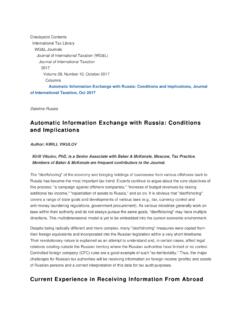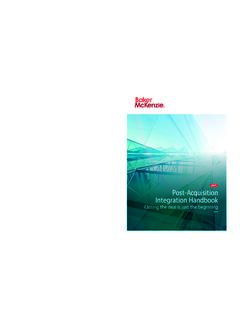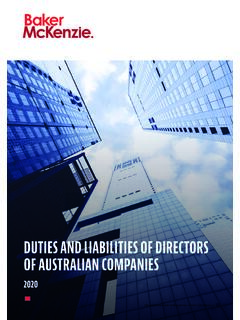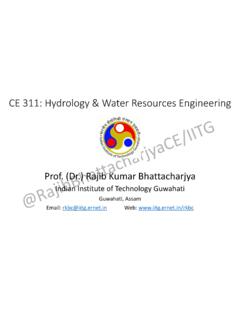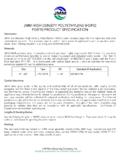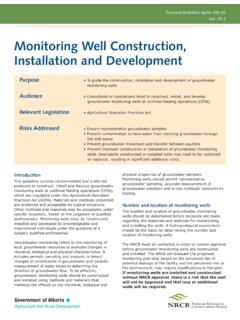Transcription of Doing Business in Egypt - Baker McKenzie
1 Doing Business in Egypt2016 Doing Business in Egypt Doing Business in Egypt Table of Contents 1. Introduction .. 1 2. Corporate Structures .. 6 3. Investment Law Incentives and Guarantees .. 15 4. Ownership of Real Estate in Egypt .. 21 5. The Banking Sector .. 23 6. Currency & Exchange Control .. 24 7. The Capital Market Law .. 26 8. Egyptian Labor Law 12 of 2003 .. 30 9. Public Enterprise Law and PPPs .. 34 10. Public Tender Law .. 36 11. Sale of Goods .. 38 12. Consumer 39 13. Anti-Dumping & Competition Law .. 42 14. Intellectual Property Law .. 45 15. Industrial Sectors .. 49 16. Taxation in 58 17. Environmental 61 18. Dispute Settlement .. 64 19. Conclusion .. 67 PREFACE This Doing Business In Egypt report has been prepared with the aim of providing a guide of the Egyptian laws as they currently stand and as are relevant to conducting Business operations in the Egyptian market.
2 In this guide, we have set forth a brief explanation of the laws pertaining to various aspects of Business in Egypt to serve as a general overview of the legal framework within which investors and companies operate. This guide is not intended to be exhaustive or to provide specific legal advice with respect to particular facts and circumstances on which we would urge the reader to seek legal assistance. Prepared by: Mohamad Talaat, Soliman Abdel Dayem, Hady Gouda, Aya Fasih and Mohab Hassan. Doing Business in Egypt List of Acronyms CAPMAS Central Agency for Public Mobilization and Statistics CBE Central Bank of Egypt COMESA Common Market for Eastern and Southern Africa CPA Consumer Protection Agency EEAA Egyptian Environmental Affairs Agency EFSA Egyptian Financial Supervisory Authority EGP Egyptian Pounds EGPC Egyptian General Petroleum Corporation EMEA European Medicines Evaluation Agency FDA US Food and Drug Administration GAFI General Authority for Investments and Free Zones ICC International Chamber of Commerce ICH International Conference on Harmonization of Technical Requirements for Registration of Pharmaceuticals for Human Use IMF International Monetary Fund MHLW Japanese Ministry of Health.
3 Labor and Welfare MOHP Ministry of Health and Population NTRA National Telecommunication Regulatory Authority PPP Public Private Partnership SEZ Special Economic Zone TGA Australian Therapeutic Goods Administration TIFA Trade and Investment Framework Agreement UNCITRAL United Nations Commission on International Trade Law WIPO World Intellectual Property Organization WTO World Trade Organization Doing Business in Egypt Baker & McKenzie 1 1. Introduction Geography and Climate Egypt occupies 1,001,450 square kilometers of Northern Africa, bordering the Mediterranean and the Red Seas, Libya, the Gaza Strip, Israel and Sudan. The terrain is mostly vast desert plateau interrupted by the Nile valley and delta. Three percent of the land is arable, and about of the total land area is under irrigation.
4 Agricultural land is currently being lost due to urbanization and windblown sands, although some land is being reclaimed through irrigation. There are limited fresh water resources other than the Nile, which is the only perennial water resource in Egypt . Egypt controls the Sinai Peninsula, which is the only land bridge between Africa and Asia. Additionally, it controls the Suez Canal, which is a sea canal linking the Indian Ocean with the Mediterranean Sea. Egypt s natural resources include petroleum, natural gas, coal, iron ore, phosphates, manganese, limestone, gypsum, talc, lead and zinc. The climate is hot and dry, with the temperature in Cairo during the mid-winter months ranging from 8 C to 18 C, rising to an average maximum temperature of 36 C in July, the hottest month.
5 Even in the wettest months, particularly December, only an average of five millimeters of rainfall is recorded. Population and Language Egypt is the most populous country in the Arab world, with a total population of 90 million according to the latest estimates in 2015 by the Central Agency for Public Mobilization and Statistics (CAPMAS). Major cities include Cairo, the capital, Alexandria, Aswan, Asyut, Port Said, Suez and Ismailia. The overwhelming majority of Egypt s population lives in Cairo and Alexandria, and along the Nile Banks, Nile Delta and the Suez Canal. There are small communities through desert regions of Egypt , which are clustered around oases and historic trade and transportation routes. The population of those living in the rural areas of Egypt continues to decrease as people move to the cities in search of employment and higher living standards.
6 Arabic is the official and dominant language in Egypt , however, English and French are widely spoken and understood by the educated classes. Religion Ninety percent of the Egyptian population are Sunni Muslims, and the remaining are principally Christians (mostly Coptic Christians). Infrastructure Egypt s transportation system is relatively developed, with over 65,050 kilometers of primary and secondary roadways. Over the past years, the numbers of licensed automobiles has increased tremendously, leading to a highly congested road system, especially in urban areas. The railway network (5,500 kilometers) is the oldest railway network in Africa and the Middle East, and is essentially focused on the Nile Delta and Valley with lines fanning out from Cairo and stretching out from the south of the country to the north.
7 2 Baker & McKenzie Cairo s new underground metro system, established in 1987, is one of the busiest in the world, and is run by the National Authority for Tunnels. The country has 3,500 kilometers of waterways, including the Nile River, Lake Nasser, the Alexandria-Cairo waterway and numerous other smaller canals in the Nile Delta. In addition, the Suez Canal ( kilometers), the major waterway of international commerce and navigation, linking the Mediterranean Sea with the Gulf of Suez and the Red Sea, is navigable by oceangoing vessels drawing up to meters (as of 2010). The principal ports in Egypt are Alexandria and Port Said, however, other important ports are Damietta, El Dekheila, and Sidi Kurayr, Ayn Sukhnah and Suez on the Gulf of Suez.
8 In 2010, Egypt had a total of 86 airports, 73 of which had paved runways, the largest being the Cairo International Airport. Electricity is supplied almost all over the country. 84% of Egypt electric generating capacity is thermal (natural gas), while about 16% of the total energy generated in Egypt is hydroelectric energy, mostly generated from the Aswan High Dam. However, due to the annual population growth rate of , there is an ever increasing demand for energy resources. Plans to build power plants and to undergo limited privatization of the electric power sector are currently being considered. While water supply infrastructure has substantially improved since 1990, whereby piped water supply has increased from 89% to 99% in urban areas and from 39% to 82% in rural areas, however, only one third of the population is connected to sanitary sewers.
9 Issues of water scarcity and quality pose urgent problems to modern and future water resource management in Egypt . Telecommunication services in Egypt have been extensively upgraded and are considered relatively modern. Main lines telephone services are provided by the government-controlled Telecom Egypt , with an estimate of million lines in 2009. There are three main mobile cellular service providers, Mobinil, Vodafone Egypt and Etisalat Egypt , with an estimated total number of million users in 2009. Legal System Egypt s legal system is based on Islamic law (Shar ah) and Napoleanic codes, including the French Code Civil, upon which the Egyptian civil code is largely based.
10 Under President Mubarak s successive governments, the courts have demonstrated increasing independence, and the principals of due process and judicial review have gained greater respect. Marriage and family law are primarily based on the religious law of the individual concerned, which for most Egyptians is Islamic law. Islamic law is not forced upon non-Muslims, and non-Muslims have their own courts to settle marriage and family matters. While there have been moves to consolidate the influence of the Shari ah, commercial law remains based on modern commercial practice. Egypt s Arbitration Law 27 of 1994, as amended, serves as a framework for arbitration of domestic and international commercial disputes, as well as disputes between public enterprises and the private sector.

